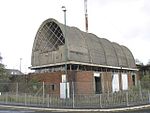Mynydd Llangatwg

Mynydd Llangatwg or Llangattock Mountain is a hill in the Brecon Beacons National Park in the county of Powys, south Wales. It is named from the village of Llangatwg (or 'Llangattock') which sits in the valley of the River Usk to the north of it. It is essentially an undulating plateau rising in the west to a height of 530 metres (1,740 ft) at grid reference SO171157 and in the east to a height of 529 metres (1,736 ft) at Hen Dy-aderyn / Twr Pen-cyrn. This spot is marked by a trig point. The shallow pool of Pwll Gwy-rhoc sits in a broad depression towards the northern edge of the plateau whilst a smaller pool frequently occupies a large shakehole a few hundred metres to its west. The hill forms an impressive northern scarp overlooking the Usk valley and commonly referred to as the Llangattock Escarpment. Its southern margins are more subdued. Its eastern end is defined by the drops into the Clydach Gorge. Beyond the B4560 to the west the hill merges with Mynydd Llangynidr which has a similar character. Particular features of note include 'The Lonely Shepherd', an isolated limestone pinnacle which stands at the eastern tip of the plateau, left there by quarryworkers who removed great quantities of the surrounding rock. A number of cairns are scattered across the hill, notably the sizeable pair which decorate the summit of Twr Pen-cyrn and which are thought to be of Neolithic age. Some freshwater ponds litter the mountain, including Pwll Gwy-rhoc the "witches pool". A more recent addition to the landscape was Cairn-Mound Reservoir which once impounded the headwaters of Nant yr Hafod on the southern slopes though Welsh Water abandoned this some years ago and its bed has revegetated, though the embankment remains. A couple of gas pipelines have been laid across the mountain and their courses can be traced variously by fences, vegetation changes and marker poles.
Excerpt from the Wikipedia article Mynydd Llangatwg (License: CC BY-SA 3.0, Authors, Images).Mynydd Llangatwg
Old Incline,
Geographical coordinates (GPS) Address Nearby Places Show on map
Geographical coordinates (GPS)
| Latitude | Longitude |
|---|---|
| N 51.8236 ° | E -3.1667 ° |
Address
Old Incline
NP8 1LF , Llangattock
Wales, United Kingdom
Open on Google Maps







